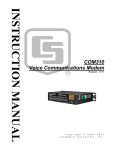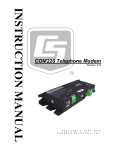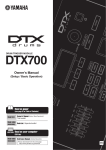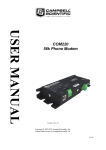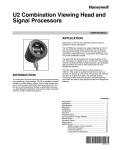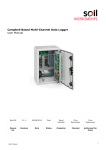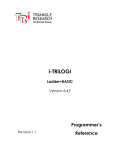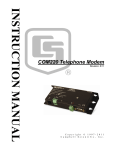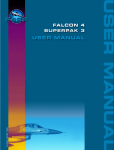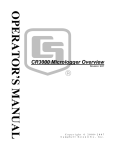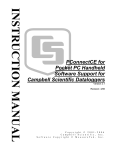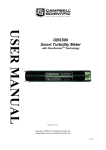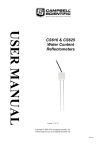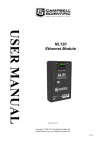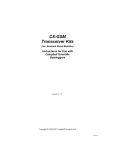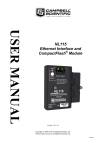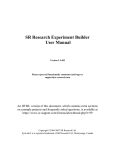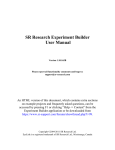Download COM320 Voice Communications Modem
Transcript
USER MANUAL COM320 Voice Communications Modem Issued: 24.11.15 Copyright © 2002-2015 Campbell Scientific, Inc. Printed under licence by Campbell Scientific Ltd. CSL 813 Guarantee This equipment is guaranteed against defects in materials and workmanship. We will repair or replace products which prove to be defective during the guarantee period as detailed on your invoice, provided they are returned to us prepaid. The guarantee will not apply to: Equipment which has been modified or altered in any way without the written permission of Campbell Scientific Batteries Any product which has been subjected to misuse, neglect, acts of God or damage in transit. Campbell Scientific will return guaranteed equipment by surface carrier prepaid. Campbell Scientific will not reimburse the claimant for costs incurred in removing and/or reinstalling equipment. This guarantee and the Company’s obligation thereunder is in lieu of all other guarantees, expressed or implied, including those of suitability and fitness for a particular purpose. Campbell Scientific is not liable for consequential damage. Please inform us before returning equipment and obtain a Repair Reference Number whether the repair is under guarantee or not. Please state the faults as clearly as possible, and if the product is out of the guarantee period it should be accompanied by a purchase order. Quotations for repairs can be given on request. It is the policy of Campbell Scientific to protect the health of its employees and provide a safe working environment, in support of this policy a “Declaration of Hazardous Material and Decontamination” form will be issued for completion. When returning equipment, the Repair Reference Number must be clearly marked on the outside of the package. Complete the “Declaration of Hazardous Material and Decontamination” form and ensure a completed copy is returned with your goods. Please note your Repair may not be processed if you do not include a copy of this form and Campbell Scientific Ltd reserves the right to return goods at the customers’ expense. Note that goods sent air freight are subject to Customs clearance fees which Campbell Scientific will charge to customers. In many cases, these charges are greater than the cost of the repair. Campbell Scientific Ltd, 80 Hathern Road, Shepshed, Loughborough, LE12 9GX, UK Tel: +44 (0) 1509 601141 Fax: +44 (0) 1509 601091 Email: [email protected] www.campbellsci.co.uk PLEASE READ FIRST About this manual Please note that this manual was originally produced by Campbell Scientific Inc. primarily for the North American market. Some spellings, weights and measures may reflect this origin. Some useful conversion factors: Area: 1 in2 (square inch) = 645 mm2 Length: Mass: 1 in. (inch) = 25.4 mm 1 ft (foot) = 304.8 mm 1 yard = 0.914 m 1 mile = 1.609 km 1 lb (pound weight) = 0.454 kg Pressure: 1 psi (lb/in2) = 68.95 mb Volume: 1 UK pint = 568.3 ml 1 UK gallon = 4.546 litres 1 US gallon = 3.785 litres 1 oz. (ounce) = 28.35 g In addition, while most of the information in the manual is correct for all countries, certain information is specific to the North American market and so may not be applicable to European users. Differences include the U.S standard external power supply details where some information (for example the AC transformer input voltage) will not be applicable for British/European use. Please note, however, that when a power supply adapter is ordered it will be suitable for use in your country. Reference to some radio transmitters, digital cell phones and aerials may also not be applicable according to your locality. Some brackets, shields and enclosure options, including wiring, are not sold as standard items in the European market; in some cases alternatives are offered. Details of the alternatives will be covered in separate manuals. Part numbers prefixed with a “#” symbol are special order parts for use with non-EU variants or for special installations. Please quote the full part number with the # when ordering. Recycling information At the end of this product’s life it should not be put in commercial or domestic refuse but sent for recycling. Any batteries contained within the product or used during the products life should be removed from the product and also be sent to an appropriate recycling facility. Campbell Scientific Ltd can advise on the recycling of the equipment and in some cases arrange collection and the correct disposal of it, although charges may apply for some items or territories. For further advice or support, please contact Campbell Scientific Ltd, or your local agent. Campbell Scientific Ltd, 80 Hathern Road, Shepshed, Loughborough, LE12 9GX, UK Tel: +44 (0) 1509 601141 Fax: +44 (0) 1509 601091 Email: [email protected] www.campbellsci.co.uk Precautions DANGER — MANY HAZARDS ARE ASSOCIATED WITH INSTALLING, USING, MAINTAINING, AND WORKING ON OR AROUND TRIPODS, TOWERS, AND ANY ATTACHMENTS TO TRIPODS AND TOWERS SUCH AS SENSORS, CROSSARMS, ENCLOSURES, ANTENNAS, ETC. FAILURE TO PROPERLY AND COMPLETELY ASSEMBLE, INSTALL, OPERATE, USE, AND MAINTAIN TRIPODS, TOWERS, AND ATTACHMENTS, AND FAILURE TO HEED WARNINGS, INCREASES THE RISK OF DEATH, ACCIDENT, SERIOUS INJURY, PROPERTY DAMAGE, AND PRODUCT FAILURE. TAKE ALL REASONABLE PRECAUTIONS TO AVOID THESE HAZARDS. CHECK WITH YOUR ORGANIZATION'S SAFETY COORDINATOR (OR POLICY) FOR PROCEDURES AND REQUIRED PROTECTIVE EQUIPMENT PRIOR TO PERFORMING ANY WORK. Use tripods, towers, and attachments to tripods and towers only for purposes for which they are designed. Do not exceed design limits. Be familiar and comply with all instructions provided in product manuals. Manuals are available at www.campbellsci.eu or by telephoning +44(0) 1509 828 888 (UK). You are responsible for conformance with governing codes and regulations, including safety regulations, and the integrity and location of structures or land to which towers, tripods, and any attachments are attached. Installation sites should be evaluated and approved by a qualified engineer. If questions or concerns arise regarding installation, use, or maintenance of tripods, towers, attachments, or electrical connections, consult with a licensed and qualified engineer or electrician. General • Prior to performing site or installation work, obtain required approvals and permits. Comply with all governing structure-height regulations, such as those of the FAA in the USA. • Use only qualified personnel for installation, use, and maintenance of tripods and towers, and any attachments to tripods and towers. The use of licensed and qualified contractors is highly recommended. • Read all applicable instructions carefully and understand procedures thoroughly before beginning work. • Wear a hardhat and eye protection, and take other appropriate safety precautions while working on or around tripods and towers. • Do not climb tripods or towers at any time, and prohibit climbing by other persons. Take reasonable precautions to secure tripod and tower sites from trespassers. • Use only manufacturer recommended parts, materials, and tools. Utility and Electrical • You can be killed or sustain serious bodily injury if the tripod, tower, or attachments you are installing, constructing, using, or maintaining, or a tool, stake, or anchor, come in contact with overhead or underground utility lines. • Maintain a distance of at least one-and-one-half times structure height, or 20 feet, or the distance required by applicable law, whichever is greater, between overhead utility lines and the structure (tripod, tower, attachments, or tools). • Prior to performing site or installation work, inform all utility companies and have all underground utilities marked. • Comply with all electrical codes. Electrical equipment and related grounding devices should be installed by a licensed and qualified electrician. Elevated Work and Weather • Exercise extreme caution when performing elevated work. • Use appropriate equipment and safety practices. • During installation and maintenance, keep tower and tripod sites clear of un-trained or non-essential personnel. Take precautions to prevent elevated tools and objects from dropping. • Do not perform any work in inclement weather, including wind, rain, snow, lightning, etc. Maintenance • Periodically (at least yearly) check for wear and damage, including corrosion, stress cracks, frayed cables, loose cable clamps, cable tightness, etc. and take necessary corrective actions. • Periodically (at least yearly) check electrical ground connections. WHILE EVERY ATTEMPT IS MADE TO EMBODY THE HIGHEST DEGREE OF SAFETY IN ALL CAMPBELL SCIENTIFIC PRODUCTS, THE CUSTOMER ASSUMES ALL RISK FROM ANY INJURY RESULTING FROM IMPROPER INSTALLATION, USE, OR MAINTENANCE OF TRIPODS, TOWERS, OR ATTACHMENTS TO TRIPODS AND TOWERS SUCH AS SENSORS, CROSSARMS, ENCLOSURES, ANTENNAS, ETC. Contents PDF viewers: These page numbers refer to the printed version of this document. Use the PDF reader bookmarks tab for links to specific sections. 1. Introduction ................................................................ 1 2. Specifications ............................................................ 2 3. Quickstart ................................................................... 2 4. System Components ............................................... 10 4.1 4.2 4.3 4.4 COM320 Modem ............................................................................... 10 Surge Suppressor ............................................................................... 11 Voice Capable Dataloggers ................................................................ 11 Telephone........................................................................................... 11 5. Datalogger Voice Programming ............................. 11 5.1 5.2 5.3 5.4 5.5 Features .............................................................................................. 11 5.1.1 Callback ...................................................................................... 12 5.1.1.1 Data Callback ................................................................... 12 5.1.1.2 Voice Callback ................................................................. 12 5.1.2 Voice Callin ................................................................................ 12 5.1.3 Voice Storage Data ..................................................................... 12 Voice Instructions .............................................................................. 12 5.2.1 VoiceBeg / EndVoice ................................................................. 12 5.2.2 VoiceSpeak ................................................................................. 13 5.2.3 VoiceKey .................................................................................... 13 5.2.4 VoiceNumber .............................................................................. 13 5.2.5 DialVoice .................................................................................... 13 5.2.6 VoiceHangup .............................................................................. 14 5.2.7 VoiceSetup .................................................................................. 14 5.2.8 VoicePhrases ............................................................................... 14 Data Callback ..................................................................................... 14 5.3.1 Example Data Callback Program ................................................ 14 5.3.2 Data Callback Instructions .......................................................... 16 Answer in Data Mode ........................................................................ 17 LoggerNet .......................................................................................... 17 6. Hardware Installation............................................... 17 6.1 6.2 6.3 6.4 6.5 Site Requirements .............................................................................. 17 Powering the COM320 Modem ......................................................... 19 Grounding the COM320 System ........................................................ 19 Telephone Service .............................................................................. 20 Connecting to a Surge Protector ........................................................ 21 7. Troubleshooting COM320 Voice Systems ............. 22 7.1 7.2 No Communications .......................................................................... 22 Communications Problems ................................................................ 23 i Appendices A. IC Information ........................................................ A-1 CP-01, Issue 8, Part I Section 14.1 ............................................................. A-1 CP-01, Issue 8, Part I Section 14.2 ............................................................. A-1 B. Updating and Configuring the COM320 ............... B-1 B.1 B.2 B.3 B.4 B.5 B.6 Removing the Cover to Access the USB Port .................................. B-1 COM320 USB Communications Cable ........................................... B-1 COM320 Driver Installation ............................................................ B-1 Downloading a New Operating System to the COM320 ................. B-2 Changing COM320 Settings ............................................................ B-3 Retrieving a Vocabulary List ........................................................... B-5 C. CS I/O 9 Pin Serial Port.......................................... C-1 Pin Description ............................................................................................ C-1 D. COM320 Word List ................................................. D-1 D.1 COM320 Word List - Alphabetical Order ...................................... D-1 1-1. 6-1. 6-2. 6-3. 6-4. 6-5. B-1. B-2. B-3. C-1. COM320 Voice Synthesizer Modem ................................................... 1 COM320 Hardware Connection Using Standard RJ11 Phone Jack ... 18 COM320 / CR1000 Using Surge Protection Device (where there’s no available Standard RJ11 Connection) ............................ 19 COM320 Grounding and Alternate 12VDC Power ........................... 20 Top View of Surge Suppressor Wiring .............................................. 21 Side View of Surge Suppressor Wiring ............................................. 22 Send OS Screen in Device Configuration ........................................ B-3 Device Configuration Screen ........................................................... B-4 Device Configuration Settings Editor .............................................. B-4 COM320’s Male 9 Pin Connector.................................................... C-1 C-1. Pin Description................................................................................. C-2 Figures Tables ii COM320 Voice Communications Modem 1. Introduction The COM320 is a voice-synthesized modem that supports the CR800, CR850, CR1000, and CR3000 dataloggers. The COM320 allows the datalogger to announce over the telephone specific variable data, present state of flags and/or control ports, and the ability to toggle flags and/or control ports. Along with announcing information over the phone, the datalogger can also be programmed to call specific phone numbers with different messages when specific conditions are met. Although the primary function of the COM320 is voice communications, the modem is also capable of data communications. In data mode the COM320 supports standard datalogger functions including program send, data collection, and data callback. This manual provides information regarding COM320 specifications, installation, and operation. Section 3, Quickstart, presents an example CR1000 voice callback/callin program with descriptions of the code. Section 6.3, Grounding the COM320 System, explains how to make a good earth ground connection to maximize protection of the COM320 against lightning and electro-static discharge. Figure 1-1. COM320 Voice Synthesizer Modem 1 COM320 Voice Communications Modem 2. Specifications Standards: V.92, K56Flex, V.90, V.34, V.32bis, V32, V23, V22bis, V22, V.21, B212, B103 Registration: FCC US: 3A4M508BSM2-T-W IC 2377 A-SM2TW TBR21 Datalogger interface: CS I/O, SDC9 (Only one device using SDC9 can be connected to the CS I/O port.) Operating voltage: 12 Vdc Current drain: 100 μA quiescent; 35 mA active Operation: Full-duplex over standard analogue phone lines Operating temperature: –25 to 50 °C std, –55 to 85 °C optional Dimensions: 16.5 x 2.5 x 6.6 cm (6.5 x 1.0 x 2.6 in) Weight: 0.16 kg (0.35 lb) For information regarding the COM320 theory of operation refer to Appendix A, IC Information, of this manual. 3. Quickstart This section presents Basic_Voice_2.cr1 an example voice callback/callin program written to demonstrate functions of the COM320. It can serve as a starting point from which to build an application program. Test the autodisconnect capability as you customize the voice code and merge your measurement sections with the voice code. To demo the example program, obtain the following items or their equivalent: 1) 2) 3) 4) 5) 6) 7) 8) NOTE COM320 (COM320_OS.03 or later OS) SC12 Cable CR1000 datalogger 3 inches of thermocouple wire PS100 Power Supply Phone modem for your PC LED in series with 1000 Ohm resistor Analogue phone line The COM320 cannot interface with office digital phone lines. Connect the COM320 to analogue phone lines only, such as a fax line. You will also need: 1) Windows compatible PC with available COM port 2) LoggerNet 3.4.1 or later installed on PC. 2 User Manual The datalogger’s voice code is created along with the measurement program using the CRBasic editor. It is recommended to finish and debug the voice portion of the program first, and then add the measurement code. The example CR1000 voice callback/callin program that follows supports the following functions: Voice callin Voice callback Auto-disconnect Auto redial Alarm reset The following steps show how to build a station to demo the example voice callback/callin program. The voice station can further serve to test/debug a custom voice program and merge it with an application program. Step 1 – LoggerNet Setup 1) In LoggerNet Setup create the following device map 2) Configure ComPort and PhoneBase for your PC’s phone modem. 3) Configure PhoneRemote to include the COM320’s analogue phone number followed by six commas and a 9. 4) Click on CR1000phone (renamed) and verify that the PakBus Address is 1. Step 2 – Hardware Setup 1) Start with a CR1000 having factory settings. If unsure of settings, close LoggerNet, connect SC12 cable from PC ComPort to CR1000 RS-232 port, run Device Configuration Utility, set Serial Port to match the PC ComPort, Connect and click on the Factory Defaults button, Apply settings and Disconnect. 2) Turn off PS100 if it isn’t already. 3) Connect CR1000 to PS100 (turned off). 4) Connect SC12 cable from COM320 to CR1000 CS I/O port. 5) Connect analogue phone line to COM320. 6) Turn on PS100. 7) Connect prepared TC to CR1000’s DIFF 7 analogue input. 8) Connect LED with 1000 Ohm resistor connected to anode lead from C1 to G (resister to C1). Step 3 – Send BASIC_VOICE_2.CR1 to CR1000 1) Download BASIC_VOICE_2.CR1 from CSI web site under Support, Downloads, Program Examples, COM310 Examples to a folder on your hard drive. 2) From LoggerNet Toolbar run CRBasic editor and open BASIC_VOICE_2.CR1. 3 COM320 Voice Communications Modem 3) Change PHONE1 (a constant in SlowSequence near bottom of program) to your office phone number to be used for callback and Save and Compile the change. 4) You can change PHONE2, etc. to nearby phone numbers for testing or comment out those lines of code. NUMPHONES should equal the number of active phone numbers. 5) If the TC at DIFF 7 isn’t Type T, change the program to match your TC type and Compile and Save. 6) Connect to CR1000phone and in Connect Screen, File Control send BASIC_VOICE_2.CR1 to CR1000phone. 7) Close File Control and Disconnect from CR1000phone. 8) Your CR1000 voice station is ready to demo. Step 4 – Callin 1) Using a touch-tone phone, dial the number of the analogue phone line connected to the COM320. 2) You should hear a ring or two, some faint clicking and then the voice announcements: CURRENT STATION DATA PRESS ONE TO HEAR THE BATTERY VOLTAGE PRESS TWO TO HEAR THE DATALOGGER TEMPERATURE PRESS THREE TO HEAR THE T C TEMPERATURE PRESS STAR TO DISCONNECT 3) Pressing 1, 2, 3, or * should produce the result indicated. Step 5 – Callback 1) Grip the end of the thermocouple to raise its temperature above 85F setting an alarm condition. 2) In a few seconds you should be able to detect the dial tones as a voice callback proceeds. The first phone number in the program should ring. Picking up the phone you should hear: PRESS POUND TO RESET ALARM, PRESS STAR TO DISCONNECT Pressing the # key you should hear: C R ONE THOUSAND STATION PRESS ONE TO HEAR A SENSOR VALUE PRESS TWO TO HEAR OR TOGGLE PORT PRESS THREE TO HEAR OR TOGGLE FLAG PRESS STAR TO DISCONNECT 3) Navigate around in the menus to learn the program’s capabilities: a) Press 2 to access the Ports Menu. b) Press 1 to read the logic state of Control Port 1. c) Press # to toggle the logic state of Control Port 1 (C1’s LED should turn on). d) Press # again (C1’s LED should turn off). 4 User Manual e) Press * to return to “C R ONE THOUSAND STATION” menu. f) Press * to hang up. 4) Try hanging up the phone without pressing * (disorderly exit) and see if the modem automatically hangs up after a few seconds. 5) As you press the keys to navigate around in the menus you will find that occasionally you get an unexpected response. Phone connections are susceptible to noise pickup and signal attenuation. Depending on your particular phone equipment and the phone lines and equipment between you and the voice station, you may at times experience some of the following: a) You press * and the voice station hangs up but doesn’t say, “Goodbye.” b) A voice callback rings your phone but you pick up to silence Certain phones are more of a problem due to low signal levels or switch bounce. 6) Helpful hints for pressing phone keys to control a voice station a) Press a key firmly (but not too long). b) Allow a second between key presses. c) Press the same key again if getting an incorrect response. d) If no response, try pressing the same key again or press the # key to recover. e) If unresponsive, try rapidly pressing a series of five * keys to disconnect station. f) Worst case, hang up and allow 6 minutes for the voice station to reset itself. Following is the text of the BASIC_VOICE_2.CR1 example voice callback/callin program employing VoiceSetup( ). The program should be available for download on CSI’s website under Support/Downloads/Program Examples. Following the program is a description of its main sections. 5 COM320 Voice Communications Modem ' CR1000 ' BASIC_VOICE_2.CR1 ' Program employs VoiceSetup instruction available in OS CR1000.Std.12 and later ' ' ‘ ' 1st phone number is called if Diff 7 TC temperature > 85F Program continues to call callback phone number list until someone answers and presses # key resetting alarm. Callback phone numbers are in constants in the SlowSequence at the bottom of the program. ' ' ' ' ' ' Key Press Functions: # resets alarm condition or toggles port/flag 1,2,3,4,5,6,7,8 select certain menu items * returns one menu level (returns from subroutine) or disconnects 0 is not used in this program 9 should be avoided since it will trigger an attempt to connect to a modem ' Timeouts (for key presses and for the total on line time) are constants listed below ' and can be adjusted. Public Value(3) Alias Value(1) = BatteryV Alias Value(2) = PTemp Alias Value(3) = TCValue_F Const Const Const Const Const Const KeyTimeout = 800 SecsOnLine = 360 STAR = 42 POUND = 35 HangupIfKeyTimeout = TRUE RINGTIME = 20 ' 8 second timeout waiting for key stroke before hangup ' 6 minutes On Line Timeout ' The * key (STAR) ' The # key ' Will hangup if times out waiting for a key ' Maximum time, in seconds, allowed for a phone to be picked up and # pressed Public mykey As Long ' **** VOICE CODE executed when DL detects COM320 RING or when DialVoice() succeeds **** Public CallingOut As Boolean ' Detects whether we are calling out or calling in ' STAR (*) key will be used to return from subroutines and to disconnect if not in a subroutine VoiceSetup (STAR,STAR,0,SecsOnLine,HangupIfKeyTimeout,CallingOut) VoiceBeg If CallingOut Then Call CallOutVoice Else Call CallInVoice EndIf EndVoice ' We are calling out triggered by DialVoice() ' We are calling in ' ***** Subroutines ***** ' Called when calling in: Sub CallInVoice Do VoiceSpeak ("CURRENT STATION DATA 50MS 50MS", 0) VoiceSpeak ("PRESS ONE TO HEAR THE BATTERY VOLTAGE 50MS", 0) VoiceSpeak ("PRESS TWO TO HEAR THE DATALOGGER TEMPERATURE 50MS", 0) VoiceSpeak ("PRESS THREE TO HEAR THE T C TEMPERATURE 50MS", 0) VoiceSpeak ("PRESS STAR TO DISCONNECT", 0) Select Case VoiceKey(keytimeout) Case 1 VoiceSpeak ("THE BATTERY VOLTAGE IS" + Value(1) + "VOLTS", 1) Case 2 VoiceSpeak ("THE REFERENCE IS" + Value(2) + "DEGREES", 1) Case 3 VoiceSpeak ("THE AIR TEMPERATURE IS" + Value(3) + "DEGREES", 0) EndSelect Loop ' Until timeout or STAR EndSub ' Called when calling out: 6 User Manual Public Alarm As Boolean, ArmAlarm As Boolean, ManualAlarm As Boolean Sub CallOutVoice ' Dial # reset to reset alarm = 0 Timer(1,Sec,2) ‘ Start timer Do VoiceSpeak("50MS PRESS POUND TO RESET ALARM 50MS PRESS STAR TO DISCONNECT", 0) mykey = VoiceKey(0) If Timer(1,Sec,4) >= RINGTIME Then ExitSub ' Max time to await pick up and # press Loop Until mykey = POUND ' Someone cleared the alarm, let them proceed and do other things Alarm = False Do ' Until timeout VoiceSpeak ("50MS C R ONE THOUSAND STATION 50MS 50MS", 0) VoiceSpeak ("PRESS ONE TO HEAR A SENSOR VALUE 50MS 50MS", 0) VoiceSpeak ("PRESS TWO TO HEAR OR TOGGLE PORT 50MS 50MS", 0) VoiceSpeak ("PRESS STAR TO DISCONNECT 50MS 50MS", 0) Select Case VoiceKey(KeyTimeout) Case 1 Call SubKey1 Case 2 Call SubKey2 Case 3 Call SubKey3 EndSelect Loop ' Until timeout EndSub ' Monitors a value Sub SubKey1 Do VoiceSpeak ("50MS PRESS SENSOR NUMBER 50MS PRESS STAR TO RETURN", 0) mykey = VoiceKey (KeyTimeout) If mykey = 1 Then VoiceSpeak ("50MS THE BATTERY VOLTAGE IS" + Value(1) + "VOLTS", 1) If (mykey = 2) Then VoiceSpeak ("50MS THE REFERENCE IS" + Value(2) + "DEGREES", 1) If (mykey = 3) Then VoiceSpeak ("50MS THE T C IS" + Value(3) + "DEGREES", 1) Loop ' Sensor value loop EndSub ' Read a port and possibly toggle Sub SubKey2 Do ' Until * or timeout Dim keybit,port As Long,state VoiceSpeak("50MS PRESS PORT NUMBER 50MS PRESS STAR TO RETURN", 0) port = VoiceKey(keyTimeout) If (port > 0) AND (port <= 8) Then keybit = 2^(port-1) ' Bit 0..7 is set in keybit. Keybit = 2^(port-1). Do ReadIO(state, &b11111111) VoiceSpeak("50MS C" + port + "IS",0) If state AND keybit Then VoiceSpeak("ON",0) Else VoiceSpeak("OFF",0) EndIf VoiceSpeak("50MS PRESS POUND TO TOGGLE 50MS PRESS STAR TO RETURN", 0) If VoiceKey(KeyTimeout) = POUND Then ReadIO (state,&b11111111) If state AND keybit Then state = state AND (NOT keybit) Else state = state OR keybit EndIf WriteIO(&b11111111,state) ' Toggle control port EndIf Loop EndIf Loop EndSub ‘ Read a flag and possibly toggle Sub SubKey3 Const NUMBERFLAGS = 8 Public Flags(NUMBERFLAGS) 7 COM320 Voice Communications Modem Do ' Until * or timeout VoiceSpeak("50MS PRESS FLAG NUMBER 50MS PRESS STAR TO RETURN", 0) mykey = VoiceKey(keyTimeout) If (mykey > 0) AND (mykey <= NUMBERFLAGS) Then Do VoiceSpeak("50MS FLAG" + mykey + "IS",0) If Flags(mykey) Then VoiceSpeak("ON",0) Else VoiceSpeak("OFF",0) EndIf VoiceSpeak("50MS PRESS POUND TO TOGGLE 50MS PRESS STAR TO RETURN", 0) If VoiceKey(KeyTimeout) = POUND Then flags(mykey) = NOT flags(mykey) Else ExitDo EndIf Loop EndIf Loop ' Port loop EndSub DataTable (Test,1,-1) DataInterval (0,0,Sec,10) Minimum (1,BatteryV,FP2,0,False) Sample (1,PTemp,FP2) Sample (1,TCvalue_F,FP2) EndTable ' BeginProg <<<<<<<<<<<<<<<<<< MEASUREMENT PROGRAM >>>>>>>>>>>>>>>>>> Scan (1,Sec,3,0) Battery (BatteryV) PanelTemp (PTemp,250) TCDiff (TCvalue_F,1,mV2_5C,7,TypeT,PTemp,True,0,250,1.8,32) ' Add measurement code here ******************* CallTable Test NextScan ' <<< VOICE CALLBACK CODE that executes when alarm conditions are met >>> SlowSequence ' Slow Sequence do loop forever possibly doing alarm call out Const NUMPHONES = 3 ' 3 phone numbers to try Const PHONE1 = "1112223333" Const PHONE2 = "1112224444" Const PHONE3 = "1112225555" Dim i,Phones(NUMPHONES) As String phones(1) = PHONE1 phones(2) = PHONE2 phones(3) = PHONE3 8 User Manual Alarm = FALSE ArmAlarm = TRUE Do ' Forever Delay(1,1,sec) If (TCvalue_F < 85) Then ArmAlarm = TRUE ElseIf (TCvalue_F > 85 AND ArmAlarm) OR ManualAlarm = TRUE Then ManualAlarm = False Alarm = TRUE' Do For i = 1 To NUMPHONES ' Call these numbers until the alarm is cleared If Alarm Then DialVoice(phones(i)) ' Calls only if alarm is set Next i If Alarm Then Delay(1,1,min) Loop Until Alarm = FALSE ArmAlarm = False EndIf Loop EndProg Example Program Description NOTE Bold text indicates a CRBasic instruction. Italic text indicates a subroutine. Basic_Voice_2.cr1 has five main sections: VoiceSetup( ) - handles auto-disconnect. Voice Beg / EndVoice - routes execution to callin or callout subroutines. CallInVoice Subroutine - executes when VoiceBeg detects a callin CallOutVoice Subroutine - executes when VoiceBeg detects a dial-up. It looks for a pound (#) key to reset “alarm” variable to false. SlowSequence - continually looks for the “alarm” variable to be true, which if it is, it dials a list of phone numbers until “alarm” is no longer true. It signals Voice Beg when a callout dial-up is in progress. VoiceSetup( ) The VoiceSetup instruction is used to control the hang up of the COM320 voice modem. It controls which key is used to exit a subroutine and which is used to continue to the next VoiceKey instruction. It also determines how long the COM320 can be ‘off hook’ before the datalogger automatically hangs it up (auto-disconnect). And it controls whether or not the modem hangs up after a VoiceKey instruction timeout. The “Callout” parameter indicates that the modem has received a ‘call in’ or has dialled a ‘call out’. 9 COM320 Voice Communications Modem WARNING The VoiceSetup SecsOnLine setting is important as it hangs up (auto-disconnects) the modem in case someone hangs up the phone or leaves the phone off-hook without pressing star keys for an orderly “good-bye” disconnect. Test the entire program in this regard before deployment to avoid possible lengthy off-hook states disallowing incoming calls, running up a phone bill and draining the station power supply. Voice Beg / EndVoice At call in, the VoiceBeg / EndVoice instruction pair encloses the code that is executed when the datalogger detects a ring from the COM320. CallInVoice Subroutine This subroutine contains the code pointed to by VoiceBeg / EndVoice that is to execute after a call in occurs. It consists mainly of VoiceSpeak menu announcements followed by a VoiceKey instruction prompting caller input and a Select Case statement choosing the program’s responses to various caller key presses. CallOutVoice Subroutine The CallOutVoice subroutine contains the code that is to execute when VoiceBeg / EndVoice detects that a call out phone number has been dialled. It prompts a responding party to press the # key after which it announces the menu selections to hear: battery voltage, panel temperature, or thermocouple temperature (SubKey1); datalogger port status of C1 - C8 (SubKey2); or datalogger flag status of F(1) - F(8) (SubKey3). The state of the ports and flags can be toggled as well as heard. SlowSequence Contains code that continually executes looking for the Diff 7 thermocouple to exceed 85 °F in which case the variable “alarm” is set to “True” and a call out (callback) is initiated. It dials the first phone number on the list. If no answer, after 20 seconds the second number is dialled. The list of phone numbers is dialled repeatedly until someone picks up and presses the # key (monitored by the CallOutVoice subroutine) which resets “alarm” to False and allows the responding party to proceed into the CallOutVoice menus. 4. System Components 4.1 COM320 Modem Connecting a COM320 voice modem to a datalogger provides all COM220 supported functions plus the following: Voice retrieval of data (user or datalogger initiated) Reading/Toggling of datalogger control ports Reading/Toggling of program Flags The COM320 ships with an SC12 cable (9-pin to 9-pin) for connecting between the modem CS I/O port and datalogger CS I/O port. 10 User Manual NOTE 4.2 The COM320’s communication port is designed to function with a Campbell Scientific CS I/O port. This is not an RS-232 port. See Appendix C, CS I/O 9 Pin Serial Port, for the CS I/O port description. Surge Suppressor If the phone company does not provide surge protection at the datalogger site, you will need to install some. CSI offers surge protectors in two forms. Item # 6362 is a surge protector with environmental enclosure mounting hardware. Item # 4330 is the surge protector with no mounting hardware (see Section 0, Connecting to a Surge Protector). 4.3 Voice Capable Dataloggers The COM320 is compatible only with the CR800, CR850, CR1000, and CR3000 dataloggers. They must have an operating system equal to, or greater than, the following: CR800/CR850 version 7, CR1000 version 16 and CR3000 version 9. It is not compatible with the CR200-series, CR5000, CR7, CR9000X, or any of our retired dataloggers. The COM320 supports such functions as program send, data collection, clock check, voice callback, voice calling, and data callback. The modem also supports concurrent communications. Dataloggers with multiple peripherals (COM320, RF450, RF401, MD485, NL115, CR1000KD, and SC32B) can communicate simultaneously via those peripherals. 4.4 Telephone A touch-tone phone is normally used to call the COM320 modem. A rotary phone will work if the programmed voice announcements do not require you to navigate through the COM320’s menu system. NOTE 5. The COM320 must connect to an analogue phone line. Some office environment PBX phone lines are digital and don’t interface to an analogue modem such as the COM320. Of course, any phone may be used to call in to or receive callbacks from the COM320. A touch-tone phone is necessary for input. Datalogger Voice Programming The voice code for the datalogger is integrated with the main program. It is probably advantageous to write your custom voice program and debug it before adding the measurement part. The example voice callback/callin program in Quickstart can provide a starting point for your program. 5.1 Features The voice instructions listed in 5.2 are combined with standard CRBasic instructions to create the code needed for telephone answering, dialling, voicing word strings, voicing data, receiving key presses from the remote phone, and acting upon those key presses. 11 COM320 Voice Communications Modem 5.1.1 Callback Callback is the ability of a datalogger/COM320 station to initiate a phone call ‘back’ to a PC running LoggerNet (data mode) or to a telephone (voice mode). Data callback and voice callback code can be included in the same program. See example CR1000 voice callback/callin program for details. 5.1.1.1 Data Callback A station can be programmed to do a data callback in the event specified conditions are met to a PC (with phone modem) running LoggerNet. Data callback causes LoggerNet to collect datalogger data marked for collection. You must enable Callback (sometimes in two places) in LoggerNet Setup. The datalogger program uses a SendVariables instruction to effect a data callback (see example data callback program below). No callback ID is used. 5.1.1.2 Voice Callback The COM320 gives you the ability to do voice callbacks. You can program a station to call one or more telephone numbers and announce an alarm message when conditions you specify are met. You can input multiple phone numbers to increase the probability that someone will receive the message. Dataloggers accomplish voice callback with a combination of VoiceSetup, VoiceKey, VoiceSpeak, and DialVoice instructions (see example voice callback/callin program). 5.1.2 Voice Callin Callin is the ability of a station to accept a phone call and announce words and data and, possibly, accept menu key presses. All voice capable dataloggers support callin. The dataloggers require that callin code be added to the program (see example voice callback/callin program in Quickstart). 5.1.3 Voice Storage Data The COM320 recites data stored in variables. You can also recite data stored in tables by setting a variable equal to Tablename.Fieldname (fieldname index, records back). You can then get a specific field from the data table (for more information see CR1000 section Program Access to Data Tables). The VoiceSpeak code might look like this: TC_1 = Public.AirTemp(1,1) VoiceSpeak ("THE AIR TEMPERATURE WAS" + TC_1 + "DEGREES", 0) 5.2 Voice Instructions The Quickstart example voice callback/callin program “BASIC_VOICE_2.CR1” provides a starting point from which to build the features you want. Patterned after the example program in Quickstart, voice instructions can be combined in a variety of ways to provide phone access to datalogger data and for control of datalogger flags/output control ports. 5.2.1 VoiceBeg / EndVoice This instruction pair contains the code executed when the datalogger detects a RING signal from the COM320 (a call in). It is placed in the declarations portion of the program before the BeginProg instruction. The EndVoice 12 User Manual instruction hangs up the modem. So, VoiceHangup is not required unless you want to hang up the modem under certain condition(s) prior to the execution of the EndVoice instruction. The VoiceKey instruction is also used to add a delay before the EndVoice instruction is executed so that the datalogger will not end the VoiceSpeak command before the spoken message is completed. 5.2.2 VoiceSpeak The VoiceSpeak() instruction defines the string spoken by the voice modem. The string is comprised of concatenated words and string variables. To ensure coded words are valid, CRBasic checks them against the voice.txt file, which mirrors the word list internal to the COM320. Voice.txt resides in the “C:\CAMPBELLSCI\LIB\COMPILER” folder. To use VoiceSpeak(), select it from the instruction list in CRBasic Editor and click Insert. CRBasic Editor brings up a list of available words. Words can be inserted in any order. Words are enclosed with quotes and variables are concatenated with words using a plus sign. For example, "50MS THE BATTERY VOLTAGE IS" + Value(1) + "VOLTS" is a valid string. The word “50MS” inserts a 50 millisecond pause during the announcement. 50MS can be inserted multiple times in series. 5.2.3 VoiceKey The VoiceKey instruction is used to add a delay before the EndVoice instruction is executed so that the datalogger does not end the VoiceSpeak command before the announcement is finished. The VoiceKey instruction’s timeout parameter is used to add a delay (in 0.01 seconds) before EndVoice or Loop is executed. Multiple VoiceKey instructions placed before an EndVoice or Loop instruction increase the delay. The VoiceKey timeout provides silent time for a user to respond to the announced menu; however, the user can respond by pressing a key in the middle of an announcement. If doing concurrent communications (via multiple communication peripherals) with your datalogger it is recommended that the VoiceKey timeout be extended to over 5 seconds. VoiceSetup’s UseTimeout parameter determines whether or not the datalogger will hang up the COM320 after the timeout in the VoiceKey instruction expires. 5.2.4 VoiceNumber The VoiceNumber instruction returns the accumulated touch tone digits that are received prior to the receipt of a # or * key. The example voice callback/callin program uses no VoiceNumber instructions; however, this instruction may be useful for phone transfer of long numbers such as for passwords, etc. 5.2.5 DialVoice The DialVoice instruction is used to define the dialling string for a COM320 voice modem, usually for voice callback. If the DialVoice instruction is set equal to a variable, a True will be returned if the communication attempt was successful or a False will be returned if it failed. VoiceHangup is used after a communication attempt to hang up the voice modem. The DialString is the telephone number and any other codes used to dial the modem. The DialString can be a variable. A comma in the DialString inserts a 2 second pause. 13 COM320 Voice Communications Modem 5.2.6 VoiceHangup The VoiceHangup instruction is used most often with the DialVoice instruction to hang up the modem after communication. The VoiceHangup instruction is not needed if the voice commands are enclosed within the VoiceBeg / EndVoice instructions. 5.2.7 VoiceSetup The VoiceSetup instruction controls the hang up of the COM320 voice modem. It also allows you to specify certain handset key functions. The HangUpKey parameter specifies the key that, when pressed, will disconnect the COM320. The ExitSubKey parameter specifies the key that will exit a subroutine if the datalogger is running one. The ContinueKey parameter specifies the key that will begin announcing the next VoiceSpeak phrase. The SecsOnLine parameter specifies the maximum number of seconds that the COM320 will be off-hook before it is hung up by the datalogger. The UseTimeout parameter determines whether or not the datalogger will hang up the COM320 after the timeout in the VoiceKey instruction expires. If this parameter is set to True, the timeout will be used. If False, the timeout will not be used. The CallOut parameter is a Boolean value that indicates the COM320 mode. When the value returned in this parameter is True the datalogger has called out. When the value is False the datalogger has received an incoming call. If the same ASCII character is used for HangUpKey and ExitSubKey, the datalogger will exit a subroutine if it is in one, otherwise, it will hang up the COM320. When the specified ContinueKey is pressed, the COM320 will skip the current VoiceSpeak string and move to the next one. If any other key is pressed, the COM320 will skip to the next group of VoiceSpeak instructions. 5.2.8 VoicePhrases The VoicePhrases instruction is used to provide a list of phrases for a VoiceSpeak instruction. This instruction allows the VoiceSpeak instruction to output a string from a list of several strings, depending upon some condition in the program. 5.3 Data Callback The COM320 can be put into data mode to accomplish data callback, instructing LoggerNet to do a collection of datalogger data. 5.3.1 Example Data Callback Program The following program (downloadable from CSI web site under Support/Download/Program Examples) does data callbacks to the phone number associated with the DialModem instruction whenever the TC temperature exceeds 85 °F. To complete the system, provide a PC running LoggerNet with a phone modem connected to the phone line dialled. 14 User Manual ' CR1000 Series Datalogger ' BASIC_DATA_CLBK_1.CR1 ' Program description: Does a DATA CALLBACK via COM320 when DIFF 7 TC temp > 85F ' LoggerNet Map: ' ComPort ' PhoneBase ' PhoneRemote ' PakBusPort ' CR1000 (PakBus Address matches remote DL) ‘ Use Type T thermocouple or change TCDiff instruction accordingly Public batt_volt, Result Public PTemp, TCvalue_F, dummy Dim DialSuccess DataTable (TestA,1,1000) DataInterval (0,0,Sec,10) Sample (1,PTemp,FP2) Sample (1,TCvalue_F,FP2) Sample (1,batt_volt,FP2) Sample (1,DialSuccess,FP2) Sample (1,Result,FP2) EndTable DataTable (TestB,1,1000) DataInterval (0,0,Sec,10) Sample (1,PTemp,IEEE4) Sample (1,TCvalue_F,IEEE4) Average (1,TCvalue_F,IEEE4,False) Sample (1,batt_volt,FP2) Sample (1,DialSuccess,FP2) Sample (1,Result,FP2) EndTable DialSequence (4094) DialSuccess = DialModem (COM320, 9600,"1112223333","") EndDialSequence (DialSuccess) 'Phone number to call BeginProg Scan (30,Sec,0,0) PanelTemp (PTemp,250) Battery (Batt_volt) dummy = 0 TCDiff (TCvalue_F,1,mV2_5C,7,TypeT,PTemp,True ,0,250,1.8,32) 15 COM320 Voice Communications Modem If TCvalue_F > 85 then SendVariables (Result,COM320,4094,4094,0000,2500,"Public","Callback",dummy,1) Delay (1,15,Sec) ‘Prevents too soon callback Endif CallTable TestA CallTable TestB NextScan EndProg In the above data callback program, the phone number is dialled in the DialSequence/EndDialSequence using the DialModem instruction. Any needed re-dials are handled by EndDialSequence (DialSuccess). LoggerNet recognizes the incoming call as a data callback by the arrival of the “Public” and “Callback” strings sent by the SendVariables instruction in the Table and Field parameters (visible in low-level log for ComPort). Callback must be enabled in both the station and the ComPort screens. The 25 second SendVariables timeout (2500 hundredths of a sec) allows the slow phone connection time to build. The program should be available for download from our website under Support/Downloads/Program Examples. 5.3.2 Data Callback Instructions The following instructions are used to program a data callback. DialSequence/EndDialSequence The DialSequence/EndDialSequence instructions are used to define the code necessary to route packets to a PakBus datalogger. Any time an instruction (SendVariables) in the main program requires that communication be made with the remote PakBus device identified by the PakBusAddr parameter (LoggerNet server with PakBus address = 4094), the DialSequence code for that datalogger will be executed. DialModem The DialModem instruction is used to send a modem dial string out one of the datalogger's ports. DialModem can be used within DialSequence / EndDialSequence to specify a communication route to be used for a PakBus device. The ResponseString is used to specify the response code expected back from the modem when a connection is made. When a null string is entered ("") the default is "1"+ CHR(13). SendVariables The SendVariables instruction is used to send value(s) from a variable or variable array to a data table in a destination PakBus device. In the example data callback program, the variable “dummy” is sent to LoggerNet as a signal for LoggerNet to begin collection of the datalogger. 16 User Manual 5.4 Answer in Data Mode In most applications the COM320 will answer with voice prompts and phrases. If a phone modem was used in making the call, in order to establish a data connection, a series of commas followed by a “9” would be appended to the dialled phone number to switch the COM320 into a data mode. Some applications may require the COM320 to answer in a data mode without the intervention of sending the “9”. This can be done via datalogger control by having a “#9” as the last or only word in a VoiceSpeak instruction. Example: VoiceSpeak(“#9”,0). You can also force the modem to hang-up by using the word “#HANGUP” as the last or only word in the VoiceSpeak instruction. 5.5 LoggerNet By default the COM320 operates in voice mode, enabling you to call a station and hear voice announcements or enabling the station to do a callback to you and announce an alarm. The COM320 also has the ability to function in data mode. In data mode, the COM320 supports data collection and other standard LoggerNet functions. You can set up LoggerNet to call and perform scheduled collections of storage data or you can program the datalogger to do callbacks under the conditions you specify at which time LoggerNet will collect the data. For scheduled (or manual) collection you change the COM320 to data mode by including six commas and a “9” in LoggerNet’s dial script in the Setup Screen’s Hardware Tab for PhoneRemote. For callback collection, the datalogger’s DialSequence instruction changes the COM320 from default voice mode to data mode. The commas create a delay so that the “9” is received by the COM320 during the voice announcement. When the COM320 detects the “9” it disables voice communications and enables data mode for the remainder of that connection. For example, in LoggerNet, if the phone number is "555-4321" then in order to call the COM320 and enable data mode the dial script becomes: "555-4321,,,,,,9" In LoggerNet a comma represents a 2 second delay. You may need to adjust the number of commas so that the “9” occurs during the voice announcement, depending upon the length of time required to establish the connection with the modem. The COM320 must be speaking when the “9” is sent. 6. Hardware Installation 6.1 Site Requirements NOTE Connection to telephone company provided COIN service (Central Office Implemented systems) is prohibited. Connection to party line service is subject to state tariffs. 17 COM320 Voice Communications Modem The COM320 is compatible with standard (analogue) telephone lines. It connects to the telephone line by means of a USOC RJ11C jack (standard modular telephone jack). Connect the cable from the telephone RJ11C jack to the modem as shown in Figure 6-1. 14-AWG Ground Wire (green with yellow stripe) Figure 6-1. COM320 Hardware Connection Using Standard RJ11 Phone Jack 18 User Manual Figure 6-2. COM320 / CR1000 Using Surge Protection Device (where there’s no available Standard RJ11 Connection) 6.2 Powering the COM320 Modem The datalogger provides 12 VDC on the CS I/O connector’s pin 8 for powering peripherals such as the COM320. 6.3 Grounding the COM320 System Connect the green 14 AWG grounding wire (provided with the COM320) to the GND terminal on the COM320 and to the station enclosure’s earth ground connection. It is important that you connect the COM320 and datalogger directly to a high quality earth ground. Read the datalogger manual section on GROUNDING for details on creating such an earth ground. WARNING A quality EARTH GROUND connection to the COM320 and datalogger maximizes protection against electro-static discharge! Follow carefully the EARTH GROUND scheme in Figure 6-3. The COM320 employs spark gaps on the phone lines; however, they will be ineffective without quality earth grounding. 19 COM320 Voice Communications Modem 14-AWG Ground Wire (green with yellow stripe) Figure 6-3. COM320 Grounding and Alternate 12VDC Power 6.4 Telephone Service Telephone companies occasionally make changes in their equipment, operations, or procedures. If you have any questions about your telephone line, such as how many pieces of equipment you can connect to it, the telephone company should be able to furnish this information upon request. If the telephone company requests information from you concerning the equipment that you have connected to your telephone line, the COM320 label shows its FCC registration number and ringer equivalence number (REN). COM320 information pertaining to the FCC and Industry Canada is available in Appendices B and C. If any of your telephone equipment is malfunctioning, you should remove it immediately from the telephone line as it may damage the telephone network. If the telephone company notices a problem from their end, they may temporarily discontinue service. They should notify you in advance of disconnection and give you opportunity to correct the problem. If not feasible, they should notify you as soon as possible. NOTE 20 If the local phone company does not provide phone-line surge protection, a Campbell Scientific surge suppressor should be used. Refer to Section 0, Connecting to a Surge Protector, for more information. User Manual 6.5 Connecting to a Surge Protector Campbell Scientific offers two surge protectors (CSI model 4330 and CSI model 6362). The 4330 and 6362 are essentially the same, except the 6362 has hardware for mounting to an enclosure backplate. NOTE The 4330 is also known as the 2374-01. The 4330 and 6362 have a protector element for each line that consists of a heavy-duty-rated, two-element gas tube, an external backup gap assembly, and a switch-grade shorting mechanism. The gas tubes (tip and ring) are sealed in a fire-resistant plastic body. DC Breakdown @ 100 V/sec is 300 to 500 volts; DC extinguishing @ 52 V, 135 V, and 150 V is less than 150 milliseconds. Figure 6-4 and Figure 6-5 show the wiring for connecting the surge suppressor. Colour coding of wires may vary. The important consideration is to follow TIP all the way through and RING all the way through. Getting wires crossed typically does not damage anything. The phone line just will not work until the wires are straightened out. CAUTION Phone wires are live, typically with low voltage (30-50 Vdc). While not harmful in most situations, Campbell Scientific recommends installing the surge protector in dry weather only by technicians with a healthy heart. Figure 6-4. Top View of Surge Suppressor Wiring 21 COM320 Voice Communications Modem Figure 6-5. Side View of Surge Suppressor Wiring 7. Troubleshooting COM320 Voice Systems Following are some possible reasons for your COM320 system not working or not working properly. 7.1 No Communications Voice Mode — No voice announcements when you call the station 1) The COM320 is connected to a digital rather than an analogue phone line. 2) The COM320 configuration was changed from its default factory settings (see Appendix B, Updating and Configuring the COM320). Data Mode — Can’t connect to the station with LoggerNet software. 1) No commas and/or “9” added to the dial string in LoggerNet to temporarily put the COM320 into data mode. 2) The “9” is being dialled before the COM320 ‘picks up’ and voices the announcement (not enough commas). 3) No phone number in the LoggerNet dial string. 4) COM320 is connected to a digital rather than an analogue phone line. 5) LoggerNet Setup configured for the wrong PC modem. 6) LoggerNet configured for a baud rate the station cannot handle (try 9600). 7) COM320 configuration was changed from its default factory settings (see Appendix B, Updating and Configuring the COM320). 22 User Manual 7.2 Communications Problems Voice Mode 1) Can’t get beyond the initial voice announcement a) The security code was not received. Try pressing # again, then xxx# again (where xxx = modem security code). 2) Pressing handset keys sometimes fails to produce the correct response. a) Handset keys not being pressed long enough. b) Key presses (especially # #) were not spaced far enough apart and the station is waiting for the last key (#). c) Phone line introducing excessive noise or signal attenuation. d) Handset introducing excessive noise or producing too low signal levels. 3) Station has become unresponsive (try the following in the order given). a) Press # which will usually announce the current menu again. b) Press five or more * (star) keys in rapid succession to recover. c) Allow station to time out and disconnect (usually 15 – 40 sec, rarely 5 min), then call again. 4) Volume levels vary. This is normal due to the PCM voice encoding compression scheme. Sometimes the modem will negotiate a higher volume for a given connection. 23 COM320 Voice Communications Modem 24 Appendix A. IC Information NOTE Industry Canada (IC) was formerly known as DOC. CP-01, Issue 8, Part I Section 14.1 “NOTICE: The Industry Canada label identifies certified equipment. This certification means that the equipment meets certain telecommunications network protective, operational and safety requirements as prescribed in the appropriate Terminal Equipment Technical Requirements document(s). The Department does not guarantee the equipment will operate to the user’s satisfaction. “Before installing this equipment, users should ensure that it is permissible to be connected to the facilities of the local telecommunications company. The equipment must also be installed using an acceptable method of connection. The customer should be aware that compliance with the above conditions may not prevent degradation of service in some situations. “Repairs to certified equipment should be coordinated by a representative designated by the supplier. Any repairs or alterations made by the user to this equipment, or equipment malfunctions, may give the telecommunications company cause to request the user to disconnect the equipment. “Users should ensure for their own protection that the electrical ground connections of the power utility, telephone lines and internal metallic water pipe system, if present, are connected together. This precaution may be particularly important in rural areas. CAUTION Users should not attempt to make such connections themselves, but should contact the appropriate electric inspection authority, or electrician, as appropriate.” CP-01, Issue 8, Part I Section 14.2 “NOTICE: The Ringer Equivalence Number (REN) assigned to each terminal device provides an indication of the maximum number of terminals allowed to be connected to a telephone interface. The termination on an interface may consist of any combination of devices subject only to the requirement that the sum of the Ringer Equivalence Numbers of all the devices does not exceed 5.” A-1 Appendix A. IC Information A-2 Appendix B. Updating and Configuring the COM320 The COM320 has an internal USB port for connecting the mode to a computer. Connection to a computer is required to install the drivers, download an operating system, change COM320 settings, and retrieve a vocabulary list. NOTE The COM320’s case must be removed to access the USB port (see Appendix B.1, Removing the Cover to Access the USB Port). B.1 Removing the Cover to Access the USB Port 1) Use a Philips screwdriver to remove the five screws on the sides of the COM320. 2) Lift off the case. B.2 COM320 USB Communications Cable The COM320 uses a USB Type-A Male to Type-B Male cable (Campbell Scientific #17648) for updating firmware, vocabulary and configuration. This is a common USB cable used with USB connected printers and scanners. B.3 COM320 Driver Installation If this is the first time a COM320 has been plugged into your computer, it will be necessary to install the drivers to enable communication with the COM320. 1) Remove the cover of the COM320 to access the USB port (see Appendix B.1, Removing the Cover to Access the USB Port). 2) Connect a USB cable between the COM320's USB port and one of your computer's USB ports. 3) Power the modem by connecting the modem’s green 12V and G terminals to a 12 Vdc power source or by connecting the modem to the CS I/O port of a datalogger. 4) Download the latest version of DevConfig from our website. Under Device Type, select Phone Modem | COM320. Click the Install the USB driver for the COM320 link and follow the prompts. B-1 Appendix B. Updating and Configuring the COM320 B.4 Downloading a New Operating System to the COM320 To download a new operating system to the COM320, follow these steps: 1) You must remove the top cover of the modem to expose the USB port. This is done by first removing the five Phillips head screws on the sides of the COM320. 2) You must also provide a power source (+12VDC) for the modem. This can be done by applying power on the green 12Vand G terminals on the device or plugging the modem into the CS I/O port of a datalogger. 3) Connect the COM320 USB port to one of the USB ports on your computer and wait for the computer operating system to load its device drivers. If this is the first time a COM320 has been plugged into your computer, you may need to install the device driver for the COM320. See Appendix B.3 for device driver installation. 4) Run Device Configuration Utility ver 1.12 or newer. 5) Select COM320 from the Device Configuration utility menu and select the Send OS tab at the top (Figure B-1). 6) Once the device drivers have been successfully loaded, you should be able to see the serial port name allocated for the modem in the PC Serial Port field when you click on the browse button. 7) Click the Start button. 8) In the resulting file open dialogue box that appears, select the file that should be sent as the modem's operating system. CAUTION Do not attempt to load any operating system other than that designed for the COM320 modem. 9) The program should now send the operating system to the modem. CAUTION B-2 Interrupting this process may corrupt the modem operating system. Appendix B. Updating and Configuring the COM320 Figure B-1. Send OS Screen in Device Configuration B.5 Changing COM320 Settings There are two items that can be configured in the COM320, the number of rings before the COM320 answers and the country code. You will need the Campbell Scientific Device Configuration Utility ver 1.12 or newer and a USB Type-A male to Type-B male cable to change these settings. 1) You must remove the top cover of the modem to expose the USB port. This is done by first removing the five Phillips head screws on the sides of the COM320. 2) You must also provide a power source (+12VDC) for the modem. This can be done by applying power on the green 12Vand G terminals on the device or plugging the modem into the CS I/O port of a datalogger. 3) Connect the COM320 USB port to one of the USB ports on your computer and wait for the computer operating system to load its device drivers. If this is the first time a COM320 has been plugged into your computer, you may need to install the device driver for the COM320. See Appendix B.3 for device driver installation. 4) Run Device Configuration Utility ver 1.12 or newer. 5) Select COM320 from the Device Configuration utility menu and select the COM320 tab at the top (Figure B-2). 6) Once the device drivers have been successfully loaded, you should be able to see the serial port name allocated for the modem in the PC Serial Port field when you click on the browse button. B-3 Appendix B. Updating and Configuring the COM320 Figure B-2. Device Configuration Screen 7) Click on the Connect button to connect to the COM320 and enter the settings editor (Figure B-3). Figure B-3. Device Configuration Settings Editor B-4 Appendix B. Updating and Configuring the COM320 CAUTION When doing datalogger to datalogger communications with the COM320, if more than six rings are specified, the datalogger may time out before the modem answers; communication will never be established! Be sure to try the set up locally before installing at a remote location. B.6 Retrieving a Vocabulary List In the case when you are unsure of the COM320’s current vocabulary, a list of words can be retrieved from the modem. You will need a USB cable, the Device Configuration Utility or terminal program, a +12 volt power supply and the COM320 drivers installed on your computer as described in the section entitled COM320 driver installation instructions. With the above requirements taken care of do the following: 1) Connect the USB cable between the computer and the COM320. 2) Apply +12 volts to the modem via the CS I/O port from a datalogger or the +12 volt and ground terminals. 3) Launch the Device Configuration Utility and select device type Unknown, the correct PC serial port connected to the COM320, a baud rate of 9600 and press the connect button. 4) By pressing the “V” key you should see a list of words scroll by in the Device Configuration Utility terminal window. If you want to save this list to a file, select the Start Export button and enter a name for the file it will create. Now press the “V” key and wait until the words stop scrolling and press the End Export button to create the file This new file is a complete vocabulary list from the COM320 voice modem. Start with the CRBasic Editor version 3.1 you can select multiple vocabulary files from the VoiceSpeak vocabulary window if the file name begins with voice and ends with .txt (i.e. VoiceTestWords.txt). The file needs to be located in the directory where the CRBasic Editor looks for its compilers (default location is C:\Campbellsci\Lib\Compilers). B-5 Appendix B. Updating and Configuring the COM320 B-6 Appendix C. CS I/O 9 Pin Serial Port NOTE The COM320’s CS I/O port is not a standard RS-232 connection. Pin Description The COM320 modem connects to the datalogger using an SC12 cable connected to the datalogger’s CS I/O port. The COM320’s connector configuration is shown in Figure C-1. Table C-1 shows the I/O pin configuration, and gives a brief description of the function of each pin. CS I/O Figure C-1. COM320’s Male 9 Pin Connector C-1 Appendix C. CS I/O 9 Pin Serial Port Table C-1. Pin Description ABR PIN O I C-2 = = = = Abbreviation for the function name. Pin number. Signal Out of the datalogger to a peripheral. Signal Into the datalogger from a peripheral. PIN ABR I/O Description 1 5V I 2 SG 3 RING O Ring: Raised by the modem to put the datalogger in the telecommunications mode. 4 RXD O Receive Data: Serial data transmitted by the modem are transmitted on pin 4. 5 ME I Modem Enable: A logic high internally switches power to the modem. A logic low internally powers down the modem. 6 SDE I Synchronous Device Enable: A logic high disables communication with the modem, without removing power or changing the modem’s mode. 8 TE I +12 VDC power supply. 9 TXD I 5 VDC supply (not used for COM320). Signal Ground: Provides a power return for pin 1 (5V), and is used as a reference for voltage levels. Transmit Data: Serial data are transmitted from the datalogger to the modem on pin 9; logic low marking (0V) logic high spacing (5V) standard asynchronous ASCII, 8 data bits, no parity, 1 start bit, 1 stop bit, 300, 1200, 9600, 76,800 baud (user selectable). Appendix D. COM320 Word List D.1 COM320 Word List - Alphabetical Order 500MS 50MS A A-M ABOVE ACCUMULATE ACKNOWLEDGE ACRE ADDITION ADDITIONAL AGAIN AGO AIR ALARM ALL AMMONIUM AND APPROACH ARE AREA AT AUTOMATION AVAILABLE AVERAGE B BACK-UP BAROMETRIC BARS BATTERY BAY BE BEAVER BEDS BEEN BEHIND BELOW BIG BILLION BLAST BOILER BUILDING BY C C-O CALCIUM CALIBRATE CALL CALLBACK CALLS CAMPBELL CAN CANAL CELSIUS CEMENT CENTI CENTRAL CHECK CHILL CHILLER CHLORIDE CHLORINE CLOSED CODE COMPUTED CONDITIONS CONDUCTIVITY CONTACT CORRECTED CREEK CROSSING CUBIC CURRENT CYCLES D D-O DAM DATA DATALOGGER DAY DAYS DEGREES DELTA DEPTH DEVIATION DEW DING DIRECTION DISCHARGE DISCONNECT DISTRICT DIVERSION DOCK DOOR DOWN DRAW DURING E E-T-O E08'S EAST EASTERN EFFLUENT EIGHT EIGHTEEN EIGHTY ELECTRON ELEVATION ELEVEN EMPTIED ENGINE ENTER EPROM EQUAL ERROR EVENT EXCEEDS EXTERNAL F FAHRENHEIT FAILED FAILURE FALL FALLING FEET FIFTEEN FIFTY FIRST FISH FIVE FLAG FLAGS FLOW FLUORIDE FOLLOWING FORTY FOUR FOURTEEN FREEZER FREQUENCY FRIDAY FROM FUEL G GALLONS GAS GATE GAUGE GENERATOR GOING GOOD D-1 Appendix D. COM320 Word List GOODBYE GRADIENT GRAM GRASS GROUND H H-2-S HAD HARDNESS HAS HASH HAVE HEAD HEAR HEAT HELLO HERTZ HIGH HOLD HOT HOUR HOURS HUMIDITY HUNDRED HYDROLOGIC I IN INCHES INDEX INF ING INPUT INTAKE INTERNAL INTRUDER IRRADIANT IRRIGATION IS IT J K KEY KILO KILOBYTES KNOTS L LAKE LAST LAYER LEVEL LINE LISTEN LISTENING LITER LOAD LOCATED LOCATION LOCATIONS LOGAN LOW D-2 M M-R-P MANAGEMENT MAXIMUM MEMORY MENDON MENU MERCURY MESSAGE METER METERS MICRO MID MID-MOUNTAIN MIDNIGHT MILES MILLI MILLION MINIMUM MINUS MINUTE MINUTES MODEM MOISTURE MONDAY MONITOR MONTH MOUNT MOUNTAIN MULTIPLIER N N-T-U NAN NEEDS NETWORK NEW NEXT NINE NINETEEN NINETY NITRATE NITROGEN NO NOON NORTH NOT NUMBER O OF OFF OFFSET OK ON ONE OPEN OR OUT OVERFLOW OVERRUNS OZONE P P-H P-M P-S-I PACIFIC PARAMETER PARTS PAST PEAK PENDING PER PERCENT PHONE PLANT PLEASE POINT POND POOL PORT PORTS POTASSIUM POUND POWDER POWER PRECIPITATION PREHEAT PRESS PRESSURE PREVIOUS PROBE PRODUCT PROGRAM PROGRESS PUMP Q QUALITY QUIT R R-P-M RACE RADIAL RADIATION RAIN RANGE RATE REACHED READING RECEIVED Appendix D. COM320 Word List REFERENCE RELATIVE RESERVOIR RESET RESIDUAL RETURN REVISION RISING RIVER ROAD ROOM RUN RUNOFF S S-O-2 SAMPLE SATURDAY SCIENTIFIC SECOND SECONDS SECURITY SEDIMENT SELECTED SELECTION SENSOR SENSORS SET SEVEN SEVENTEEN SEVENTY SHAFT SIEMENS SIGNATURE SINCE SITE SIX SIXTEEN SIXTY SKIING SMOG SNOW SODIUM SOIL SOLAR SONAR SOUTH SPEED SPILL SQUARED STAGE STANDARD STAR STATES STATION STATUS STORM STREAM STREAMBED SUMMIT SUMP SUNBURN SUNDAY SURFACE SURFACTANCE SYSTEM T Table TAIL TANK TEMPERATURE TEN TESTING THANK THAT THE THERE THIRTEEN THIRTY THIS THOUSAND THREE THRESHOLD THRU THURSDAY TIME TING TO TODAY TODAYS TOGGLE TOTAL TRIGGERED TUESDAY TURBIDITY TWELVE TWENTY TWO U ULTRAVIOLET UNITS UP V V-O-C VALUE VELOCITY VERSION VERTICAL VIA VOLTAGE VOLTS W WARNING WAS WATER WATTS WE WEATHER WEDNESDAY WELCOME WELL WEST WHAT WIND WITH X Y YEAR YESTERDAY YOU YOUR Z ZERO D-3 CAMPBELL SCIENTIFIC COMPANIES Campbell Scientific, Inc. (CSI) 815 West 1800 North Logan, Utah 84321 UNITED STATES www.campbellsci.com [email protected] Campbell Scientific Africa Pty. Ltd. (CSAf) PO Box 2450 Somerset West 7129 SOUTH AFRICA www.csafrica.co.za [email protected] Campbell Scientific Australia Pty. Ltd. (CSA) PO Box 8108 Garbutt Post Shop QLD 4814 AUSTRALIA www.campbellsci.com.au [email protected] Campbell Scientific do Brazil Ltda. (CSB) Rua Apinagés, nbr. 2018 - Perdizes CEP: 01258-00 São Paulo SP BRAZIL www.campbellsci.com.br [email protected] Campbell Scientific Canada Corp. (CSC) 14532 – 131 Avenue NW Edmonton, Alberta T5L 4X4 CANADA www.campbellsci.ca [email protected] Campbell Scientific Centro Caribe S.A. (CSCC) 300N Cementerio, Edificio Breller Santo Domingo, Heredia 40305 COSTA RICA www.campbellsci.cc [email protected] Campbell Scientific Ltd. (CSL) 80 Hathern Road, Shepshed, Loughborough LE12 9GX UNITED KINGDOM www.campbellsci.co.uk [email protected] Campbell Scientific Ltd. (France) 3 Avenue de la Division Leclerc 92160 ANTONY FRANCE www.campbellsci.fr [email protected] Campbell Scientific Spain, S. L. Avda. Pompeu Fabra 7-9 Local 1 - 08024 BARCELONA SPAIN www.campbellsci.es [email protected] Campbell Scientific Ltd. (Germany) Fahrenheitstrasse13, D-28359 Bremen GERMANY www.campbellsci.de [email protected] Campbell Scientific (Beijing) Co., Ltd. 8B16, Floor 8 Tower B, Hanwei Plaza 7 Guanghua Road, Chaoyang, Beijing 100004 P.R. CHINA www.campbellsci.com [email protected] Please visit www.campbellsci.com to obtain contact information for your local US or International representative.
















































